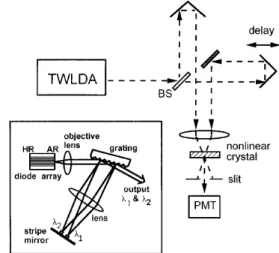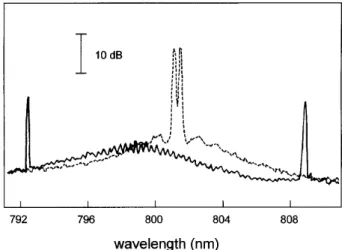May 1, 1995 / Vol. 20, No. 9 / OPTICS LETTERS 1071
Two-wavelength interferometer based on a
two-color laser-diode array and the second-order
correlation technique
Chi-Luen Wang, Yung-Hui Chuang, and Ci-Ling Pan
Institute of Electro-Optical Engineering, National Chiao Tung University, Hsinchu, Taiwan
Received January 23, 1995
A novel two-wavelength interferometer is demonstrated that uses a tunable two-color laser-diode array as the light source. The synthetic wavelength can be easily tuned from 2 to 0.043 mm by variation of the spectral separation between the two wavelengths of the laser output. By using the second-order correlation technique we can directly retrieve the phase change at the synthetic wavelength with no need for sophisticated electronic signal processing.
Two-wavelength interferometry is attractive for opti-cal path-length and surface profile measurements be-cause the measurement sensitivity can be increased and the range of unambiguity can be extended by use of a longer synthetic wavelength.1 A number of techniques have been developed for determination of the interferometric phase at the synthetic wave-length. For example, two-wavelength phase-shifting interferometry is based on changing the phase dif-ference between the two interfering beams either by the introduction of a piezoelectric transducer for modulation in one of the two arms2 or by inde-pendent alteration of the drive currents of the two laser diodes.3 The interference signal at the syn-thetic wavelength has also been determined by use of the heterodyne4
or the superheterodyne detection5 schemes; however, these techniques require rather sophisticated electronic postdetection signal process-ing. Numerical methods utilizing phase data at each wavelength have also been demonstrated.2
Experimentally, two-wavelength interferometry often requires precision alignment of two frequency-stabilized lasers. It would be a significant ad-vantage if the two required wavelengths could be generated from a single laser diode. Simultane-ous emission in two spectral regions from a multi-mode short-external-cavity laser diode operating near threshold was recently reported,6 and a two-color light-emitting-diode array was also shown to pro-vide relatively intense, stable illumination at two wavelengths.7 The synthetic wavelength, however, could not be easily tuned with either method. The side-mode suppression ratios of these light sources were also quite poor.
In this Letter we report a novel design for two-wavelength interferometry. By use of the second-order correlation technique the interference phase at the synthetic wavelength can be directly extracted without postdetection signal processing. In addi-tion, we use a tunable two-wavelength laser-diode array8(TWLDA) as the light source, simplifying both the optical system and the alignment.
Optical path-length measurement is usually
per-formed by detection of the intensity variation of the interference fringes that results from the phase dif-ference of light returning from the two arms of a Michelson interferometer. The output of the inter-ferometer can be written as
jE1sr1dj21 jE2sr2dj21 2 RefE1sr1dE2sr2dpg , (1) where E1 and E2 are the optical-field amplitudes from the two arms of the interferometer. The last term of Eq. (1) is just the first-order correlation func-tion, Gs1dsr1, r2d kE1sr1dE2sr2dpl, where the angle brackets denote the time average.9 Now consider a two-wavelength interferometer. If the intensity of each wavelength is equal to I0, the interference fringe intensity is given by
IsLd 2I01 2I0 coss2pLyLdcoss2pLyGd , (2) where L is the single-pass optical path difference, L l1l2yjl1 2 l2j is the synthetic wavelength, and G l1l2ysl11 l2d is the average wavelength.
Fig. 1. Schematic of the two-wavelength second-order correlation interferometer. BS, beam splitter; PMT, pho-tomultiplier tube; HR, highly reflective; AR, antireflec-tive. The inset shows the configuration of the TWLDA. 0146-9592/95/091071-03$6.00/0 1995 Optical Society of America
1072 OPTICS LETTERS / Vol. 20, No. 9 / May 1, 1995
Fig. 2. Laser output spectra at the maximum and mini-mum spectral separation for Dl 0.32 nm (solid curve) and Dl 17 nm (dashed curve).
In the second-order correlation technique the con-figuration of the interferometer is the same as that of a noncollinear second-harmonic autocorrelator for optical pulse measurement9 (see Fig. 1). The frequency-doubled output of the interferometer is just the second-order correlation function Gs2dsLd:
Gs2dsLd sI11 I2d 2
1 2I1I2 coss2pLyLd , (3) where I1 and I2 are the intensities of the laser at l1 and l2. The phase at the synthetic wavelength as well as the optical path-length difference L can be directly determined from the observed Gs2dsLd since coss2pLyLd hf2Gs2dsLd 2 Gmaxs2d 2 G
s2d
mingyfGmaxs2d 2 Gmins2dgj. This approach differs from the first-order correlation technique in that light intensities rather than amplitudes are compared.9
Figure 1 shows the experimental configuration. The inset shows the light source, a novel TWLDA.8 The two-wavelength output is coaxial and of the same polarization. The wavelength separation is determined by the separation of the V-shaped double-stripe mirrors, which are used as spectral filters to select the two lasing wavelengths simultaneously. By moving the stripe mirrors vertically out or into the plane of the inset of Fig. 1 we can tune the spectral separation from 0.32 to 15 nm with a side-mode sup-pression ratio better than 20 dB (see Fig. 2). This corresponds to the generation of the synthetic wave-length from 2 to 0.043 mm. The total output power of the laser at minimum and maximum spectral sepa-ration was ,10 and 1 mW, respectively, when the diode was biased at 300 6 1 mA and 20 6 0.1±
C. The threshold current of the laser was 260 mA, and the coaxial output of the TWLDA was sent into an in-terferometer. A 2-mm-long beta-barium metaborate crystal was used to generate the second-harmonic signal that is detected by a photomultiplier tube and fed to a lock-in amplifier synchronized with the frequency of a mechanical chopper and plotter for readout.
Figure 3 shows the measured optical path differ-ence as a function of actual displacement of the retroreflector at a synthetic wavelength of 0.112 nm.
The corresponding spectral separation between the two wavelengths from the TWLDA is 5.7 nm. The accuracy of the distance measurement was limited by the sensitivity of detecting the second-harmonic sig-nal. The frequency fluctuation of the TWLDA out-put and the mechanical stability of the chopper also contributed to the noise level. Since the phase mea-surement error was approximately 5 3 1022 rad, we estimated that the range resolution of the present system was ,1 mm at this synthetic wavelength. We could improve the accuracy by using a thicker second-harmonic crystal to enhance the signal and by replacing the mechanical chopper, which provides the reference signal to the lock-in amplifier, with an acousto-optic modulator.
By tuning the TWLDA to the minimum spectral separation of 0.32 nm we see that the synthetic wave-length L is equal to 2 mm and the range of phase unambiguity is as large as 0.5 mm, as shown in Fig. 4. Since the phase measurement error remains the same while the synthetic wavelength is longer than in the previous case, the accuracy of the mea-sured optical path difference deteriorates to,10 mm. If the synthetic wavelength is tuned from L1to L2 while L remains the same, the phase change can be expressed as Df 2pLDLyL2
, where DL jL12 L2j is the difference between the two synthetic wave-lengths L1 and L2. The absolute optical path dif-ference L can thus be determined by measurement of the phase change while the synthetic wavelength
Fig. 3. Measured distance as a function of the actual displacement. The synthetic wavelength is 0.112 mm.
Fig. 4. Measured distance as a function of the actual displacement. The synthetic wavelength is 2 mm.
May 1, 1995 / Vol. 20, No. 9 / OPTICS LETTERS 1073 is tuned from L1to L2. An additional advantage is
that the range of unambiguity can be increased to a much longer distance than the synthetic wavelength since phase information at L1 and L2is available.
In conclusion, we have proposed and demonstrated a novel two-wavelength interferometer. The syn-thetic wavelength is generated directly from the out-put of a two-wavelength laser-diode array and can be easily tuned from 2 to 0.043 mm. We can directly read out the phase change at the synthetic wave-length by using the second-order correlation function, and we can easily calibrate the absolute optical path difference by tuning the spectral separation of the two-wavelength laser output. The range resolution for the distance measurement was ,1 mm at a syn-thetic wavelength of 0.112 mm.
This study was partially supported by the National Science Council of the Republic of China under grant NSC84-2221-E-009-032.
References
1. C. R. Tilford, Appl. Opt. 16, 1857 (1977).
2. Y.-Y. Cheng and J. C. Wyant, Appl. Opt. 23, 4539 (1984).
3. Y. Ishii and R. Onodera, Opt. Lett. 16, 1523 (1991). 4. A. F. Fercher, H. Z. Hu, and U. Vry, Appl. Opt. 24,
2181 (1985).
5. R. Dandliker, R. Thalmann, and D. Prongue, Opt. Lett. 13, 339 (1988).
6. P. de Groot, Appl. Opt. 32, 4193 (1993).
7. L. Deck and F. Demarest, Opt. Lett. 18, 1899 (1993). 8. C.-L. Wang and C.-L. Pan, Appl. Phys. Lett. 64, 3089
(1994).
9. R. Meystre and M. Sargent III, Elements of Quantum Optics (Springer-Verlag, Berlin, 1990), pp. 19–13.

